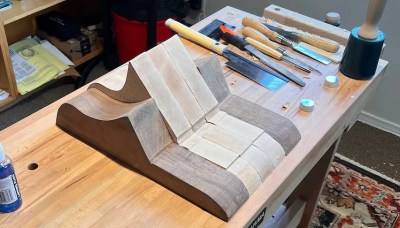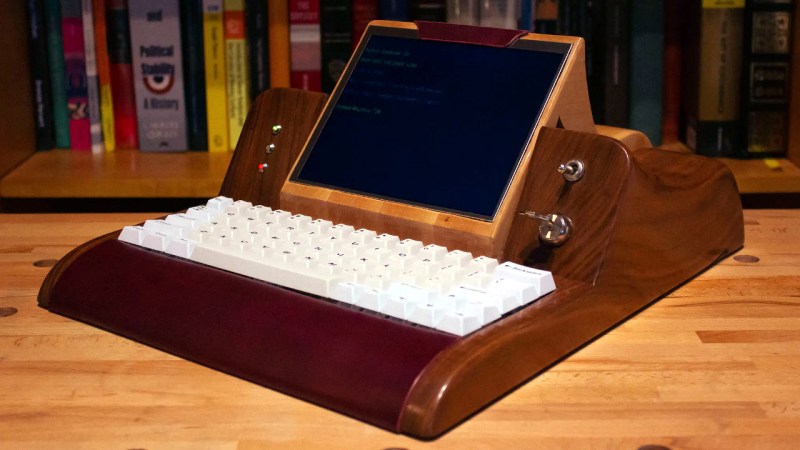While computers have become ever faster and more capable over the years, it’s hard to say they’ve become any more exciting. In fact, they’ve become downright boring. Desktop, laptop, or mobile, they’re all more or less featureless slabs of various dimensions. There’s not even much in the way of color variation — the classic beige box is now available with white, black, or metallic finishes.
Believing that such a pedestrian appearance isn’t befitting a device that puts the world’s collected knowledge at our fingertips, [Keegan McNamara] started exploring a more luxurious approach to computing. Gone is the mass produced injection molded plastic, in its place is hand-carved maple and Tuscan leather. Common computing form factors are eschewed entirely for a swooping console inspired by fine furniture and classic sports cars. The final result, called the Mythic I, is equal parts art and science. Not just a bold reimaging of what a computer can be, but an object to be displayed and discussed.

The write-up [Keegan] has prepared is a fascinating treatise on modern design and metaphysics that gives a unique insight into the thought process that went into the Mythic I computer. Those looking for slightly more technical details can check out the accompanying post on the forevercomputer mailing list.
Unfortunately we weren’t able to find any internal shots of the construction, but the mailing list post at least explained that it’s powered by an Intel NUC running a minimal Linux system which includes little more than wordgrinder. Sorry, the vi and emacs debate will have to go somewhere else.
Networking has been disabled to provide a distraction-free writing experience, though frankly, we’d have thought getting dumped into a Bash prompt at boot would already provide such an environment. To get files off of the system, [Keegan] wrote up a few scripts to simplify moving documents to and from a USB flash drive.
This isn’t the first time we’ve seen somebody attempt to create a more visually appealing desktop computer, but it’s certainly one of the most attractive and professionally done specimens to have graced these pages.
















Beautiful!
Though I wonder how ergonomic the keyboard would be if I used one.
Looks great. Perhaps swap the keyboard for something like the Felicon retro keyboard (Milk Tea) to complete the look
Yeah, some wooden keys would definitely make it look more the part. There are quite some examples on HaD: https://hackaday.com/blog/?s=wood+keyboard
Hmm that could work, though I’d think a chrome surrounded look would be more fitting – typewriter key style where the surface and legend are framed. It would IMO really match the status LED and other switch that way.
However when it comes to the keyboard more important is the feel than the look, even when artistry has been put into making the machine you want to actually use it, and you won’t if it isn’t nice to use. And I personally think this keyboard looks good in it as well – it tells you all you need to know about what the pretty wooden box is at a glance, as we all know what a keyboard looks like now (though perhaps younger generations with the smartphone taking over won’t?).
“Networking has been disabled to provide a distraction-free writing experience, ”
But how about a null-modem connection, then?
It’s file-transfer, but not networking in the classic sense.
Sure, there is (was) network software which can use COM and LPT ports for networking (Little big LAN and Kirschbaum Netz come to mind).
But LapLink/WinLink and later releases of Norton Commander can make simple connections, too.
By using a DOS VM and a shared folder, these old communications programs can be used for file-transfer on any host system.
Plus, the DOS VM or DOS EM can run WordStar, for a distraction-free writing experience. 🙂👍
Yeah but no but yeah but no!
All the wood is nice. But there is a reason for having big screens and a capable OS.
If I just want to write text, I would use a typewriter an OCR.
Well they have a very capable OS in there, and while for many use cases big screens are great I’d say any screen trumps a typewriter – as you can actually go back and edit easily when you want to, and this size and screen placement seems ideal for that – inobtrusive so you don’t have to pay attention to it at all if you are a touch typist, but large enough for when you feel a sentence/paragraph gets away from you – you can actually see and read it all back on the one screen to fix it. Nothing more annoying than a tiny display with lots of word wrapping and scrolling shenanigans just to read a sentence.
Delightful. Nearly pissed my pants. My two cents for a subtitle : “quality speaks for itself”.
As a work of art it is really very nice. As a computer I find it a massive fail.
1. A NUC is overkill any pi like SBC would be good enough to run a command line only system.
2. The screen looks fixed in the pictures so the viewing angle will be a compromise for the user.
3. The keyboard seems pretty think and not ideal ergonomically.
4. No networking to avoid distractions? Just put in FFS or SAMBA for file storage and attach a network printer of some type. No browser or email so no distractions there done.
As I said as a piece of art and of wood working it looks really good I would give it at least a B if not an A. As a computer… A waste of resources. I guess it all comes down to the purpose. But if the creator is happy with the results then that is what really matters and the workmanship is very good.
heh i don’t actually like anything about the project but in its defense i wanted to counter one of your suggestions :)
NUCs are widely available for immediate purchase on ebay, some at astonishingly low prices even if you don’t consider that you get a heck of a computer. but adafruit has been out of stock of new raspberry pis for about a year and a half now. sure, you can get them at double-price on secondary markets, or go through contortions to race to the head of the line when there is a shipment.
it’s weird to see that used NUCs remain the cheaper and more available option but i wouldn’t be surprised if that’s what infuenced Keegan’s choice
i mean there’s a strong argument they could have used an rp2040 or something *shrug*. i’m not a fan of wordgrinder either, so i’d be happy to toss out the bespoke (or niche) wordprocessor to write something from scratch for embedded ARM :)
That is why I said pi like you can get Libre sbc for like $40. I had no idea that NUCs where so cheap on Ebay. I may get one myself for a NAS idea I have.
I do admit that RP2040 idea is really interesting. You can get them to do HDMI out. If you put a Z/80 CP/M emulator on one then you would have a large choice of word processing software including WordStar. You might even get a PC emulator running on it and then have even more choices.
Of course if you wanted to write an word processor from scratch that would also make for an interesting project.
Only a waste if it is never used for anything else, though the same is true of rather more widely than just here – most peoples computers could be replaced by a SBC and they wouldn’t notice… Or conversely its not a waste at all – perhaps they are making use of the leftover computer that was otherwise rubbish, in which case it trumps a new SBC.
Interesting point. I would think that an older NUC could have a lot of other use cases but yes if you have one gathering dust I could see how this becomes less of a waste. I was thinking more of it in must compute power. Of course this is colored by the fact I am an embedded systems software engineer. It is hard sometimes to not think in those terms.
Beautiful! All it needs is a wooden keyboard…https://www.instructables.com/Wooden-Computer-Keyboard-by-Steve-M-Potter/